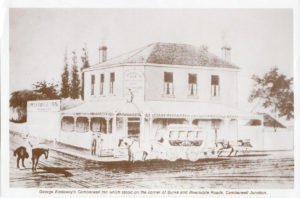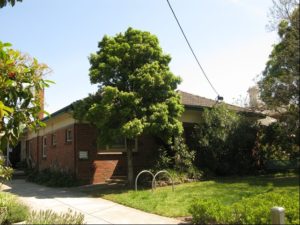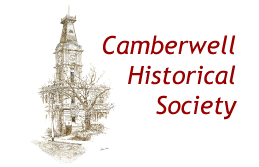History Of Camberwell

Camberwell Inn “Image sourced from Boroondara Library Service”
Camberwell is 10 kilometres east of Melbourne’s CBD. One of the city’s more affluent suburbs, it grew from the area surveyed as the Parish of Boroondara by Robert Hoddle in 1838. ‘Boroondara’ translates from Woiwurrung as ‘where the ground is thickly shaded’. John Gardiner and his family were the first Europeans to settle there in 1837.
Read More
Between 1843 and 1853 all Boroondara land was sold. Speculators then subdivided and advertised smaller blocks with European placenames such as Auburn, Merrion, Clifton, Rathmines and Hartwell. The first local government body, the Boroondara District Road Board, was formed in 1854, incorporating areas later known as Hawthorn, Kew and Camberwell. In 1860 Hawthorn and Kew became separate municipalities. The remaining area of the Road Board became Boroondara Shire in 1871. This became the City of Camberwell in 1914.
The northern part of the Parish of Boroondara eventually became part of Camberwell City. Deriving from a special survey of 5120 acres (2072 hectares) acquired by Henry Elgar in 1841, it was sold to his associates when he returned to Sydney. Subsequent subdivision and sale saw farmhouses established in the area in the late 1840s and 1850s. Pioneer settler Andrew Murray purchased one subdivision, planted a vineyard and, in about 1858, built a house he named Balwyn (after Celtic ‘bal’ or hill and Saxon ‘wyn’ or wine), the site of which is now incorporated into Fintona Girls’ School. The district surrounding adjacent Balwyn Road’s intersection with Whitehorse Road became Balwyn.
Camberwell itself it thought to be named after an inn built in 1853 by George Eastaway on the corner of several converging roads and named the Camberwell Inn because it reminded Eastaway of Camberwell Green in London. The area took the name of Camberwell and the busy intersection of streets, today known as Camberwell Junction, became a stopping point to the Gippsland gold diggings.
The Prospect Hill area is the oldest part of the suburb. The original subdivision comprised generous blocks on which fine Victorian and Edwardian houses were built. As with most of Boroondara Parish, the first mansions were erected on hilltops for the views and fresh air, most with large gardens and main road addresses. Apart from a few large houses like Sir John O’Shanassy’s Tara, residential development was limited before the railway connection in 1882.
Anglican Church services began in Camberwell in 1856, and the first St John’s Church was opened in 1863. The Catholic Church site was established in 1859 but the current Our Lady of Victories was not opened till 1918 and only consecrated in 1925. Camberwell Post Office opened on 12 October 1864 and by 1890 a grand new Post Office had been built. Camberwell Primary School (No. 888) commenced teaching in 1867, the current school retaining its Victorian frontage and part of the original building. A shire hall built in 1871 was replaced by the free classical–style town hall on Camberwell Road in 1890, the clock tower with mansard roof being added in 1924 as a memorial.
The extension of the railway in 1882 brought the area firmly into the orbit of Melbourne and, over the ensuing two decades, the population grew from 1,400 to 6,000. The main commercial centre developed along Burke Road and around Camberwell Junction. Major buildings included the Commercial Bank opened in 1889 and the Palace Hotel whose foundation stone was laid in 1888. By 1919 Camberwell had seven hotels but a state-wide local option poll in 1920 saw the city’s residents vote to close all of them, including the Camberwell Inn. The Palace Hotel, strategically placed opposite Camberwell station, survived because it was on the Hawthorn side of Burke Road.
The suburb developed further in the interwar years because the electric tram routes, which were established in 1916-17 along Burke, Riversdale and Camberwell roads, promoted residential subdivision on new estates in south Camberwell, middle Camberwell and Hartwell. The electrification of the train lines in 1916 stimulated growth and the Outer Circle Railway branch from East Camberwell to Ashburton reopened and extended to Alamein. Burke Road boomed in the 1920s. Large estates were broken up after the introduction of rates on unimproved land values. One of the features of the suburb is brick housing, mandated by Council bye-laws for many precincts from the early twentieth century. The Californian bungalow became the characteristic housing style of the area.
Rapid growth caused changes to the municipal structure; in 1902 the area was proclaimed as the Shire of Camberwell and Boroondara; 1905 saw it as the Borough of Camberwell and Boroondara; 1906 the Town of Camberwell; and 1914 as the City of Camberwell.
The former Cities of Camberwell, Hawthorn and Kew were re-amalgamated on 22 June 1994 to form the City of Boroondara.

Camberwell Historical Society rooms at 25 Inglesby Road, Camberwell
Camberwell Historical Society was founded as the City of Camberwell Historical Society (CCHS) on 10 May 1963. There are currently six historical societies within the City of Boroondara are Kew (1958), Camberwell (1963), Hawthorn (1974), Surrey Hills (1978), Canterbury (1987), and Balwyn (2008).
Read More
Committee members in the first years included: The Mayor, Cr. Ralph L. Dear (president 1963 – 1965), Fr. A. J. Martin, Graeme P. Withers, T H Woodrow, Miss J. S. Demaine, N. S. Smith, R. L. Renwick, Mrs. I. C. Lewis, Radcliffe Grace (president 1965 – 1968), E. Hibbert, and R. N. Pritchard. J. Alex Allan had been appointed as ‘Official Historian to the City of Camberwell’ in 1949 at a fee of £850 (pounds).’ He completed a 201,350 word unpublished history in 1954. Blainey’s A History of Camberwell was published in 1964.
In its early years, the Society had some members with strong links to the Royal Historical Society: four, Warren Perry, E. J. Shelden, Kitty McEwen and the Society’s president, Hal Williams were members of the RHSV council and Bill Cuthill, Victoria’s Chief Stipendiary Magistrate, was later to become that Society’s vice-president. Both Warren Perry and Bill Cuthill were later appointed as Fellows of the RHSV.
At the first annual meeting the Society decided to affiliate with the Royal Historical Society of Victoria. CHS also became a member of the Committee of Eastern Historical Societies, now Association of Eastern Historical Societies, when it was established in 1965. CHS continues to be a member of both of these organisations.
Monthly meetings in the first year included speakers such as Geoffrey Blainey, author of the soon to be published A History of Camberwell and local member Major Warren Perry, editor of the Victorian Historical Magazine. Committee meetings alternated with general meetings, a pattern which has continued until recently.
A major project was the 1967 exhibition ‘Historical Buildings of Camberwell’ in conjunction with Camberwell Camera Club which was displayed in the Theatrette of the Civic Centre. In the early years, the Society had published pamphlets on the history of Hartwell and Surrey Hills (1966) and in 1969, Glimpses of Camberwell. A one day seminar for the Victorian Committee of Affiliated Historical Societies on 31 July 1971 was also highly successful.
CHS participated in an historical exhibition at the Town Hall during the Victorian Sesqui-centenary in June 1985 and drew-up two historical walks. Many walks were organised, including the whole of the Outer Circle railway, and six ‘walks’ and a biography of Andrew Murray by Phyllis Reichl were published between 1985 and 1990. The Society, with the aid of a Council grant in 1994, was able to publish an important series of pamphlets on walks, Exploring Gardiner’s Creek and its Tributaries in Southern Camberwell. In 2002 Val Goldsworthy, a former president, compiled Plaques and Other Treasures. One of the Society’s former presidents, Volkhard Wehner published a book, Old Hartwell: the life and times of the village that lost its name, in 2012.
The Boroondara Heritage Festival of 2003 led to the collaboration of Val Goldsworthy with Peter Brady of the Camberwell Camera Club to produce ‘Decorating Boroondara with Water’, a PowerPoint presentation which illustrated the use of water in the City. Wide ranging illustrations included fountains, ponds, creeks, and water in stained glass, mostly in church windows.
Over the fifty years of its existence CHS has had five series of newsletters. The first series began in November 1963 and ran until August 1971 when the president, Hal Williams, who compiled it and who was a major driver of the Society, died after a short illness. He was succeeded by RS Demaine as president and Radcliffe Grace as secretary.
Another series of newsletters ran from 1987 to 1993. The Society issued a fourth series of the newsletter from 1996 until June 2005. Bill Mackie, Volkhard Wehner and Ken Lyall provided interesting articles over this period but it was not until 2010 that a new newsletter under the title Camberwell History was commenced with Trevor Hart as editor.
1991 saw the adoption of new rules and these were rewritten to allow the Society to register as an Incorporated Association on 30 August 2001. Honorary Memberships were awarded to Gwen McWilliam and Joyce Phillips under the new rules. Later, Wendy Baden-Powell, who had served as secretary for fifteen years, was awarded life membership in 2011.
Throughout its history, the emphasis within the Society has been on lectures and excursions. From 1989 the president, Joyce Phillips, and the secretary, Peter Doughty, kept the Society running until 1995. Following the resignation of Joyce Phillips in 1995, Geoff Kenney stepped in as president and Wendy Baden Powell as secretary. Pauline Emery and Phyllis Calvert joined the committee at this time. From 1996 – 1998 Trevor Hart was president. In 1998 Bill Mackie became president, followed by Volkhard Wehner, who was then succeeded by Val Goldsworthy between 2001 and 2003.
George Fernando took over as president when Val Goldsworthy resigned in 2003. During this time Wendy Baden-Powell served as secretary and Pauline Emery as treasurer. Stephen Watson took over as treasurer in 2010 and Adèle Fernando-Swart as secretary in 2011.
Since 2011 CHS committee has been working on a range of reforms. New rules were introduced and passed at AGMs. Policies, procedures and role statements have been developed. CHS members have been involved in the Thematic Environmental Heritage Study 2012 undertaken by Boroondara Council. CHS now has a website https://www.chs.org.au, an email address and an official address, PO BOX 1274, Camberwell, 3124. Community grants have been applied for and have, on two occasions, been successful. Planning for future progress has been undertaken.
Planning for the Jubilee celebrations started in 2012. As part of the events for the year, a speaker was scheduled for each month, a dinner was held to mark the 50th anniversary of the founding of CHS on 10 May 1963, and a tree was planted in Reed Gardens on 11 May 2013 to commemorate the occasion. The Principal Patron Professor Geoffrey Blainey gave the celebratory address at the dinner.
Camberwell Town Hall drawn by Bill Beasley in 1978 became our logo in February of 1998. In 2013 Bill Beasley was commissioned to create a new drawing of the Camberwell Town Hall which would be able to be enlarged for a banner and also give us reproduction rights. 2013 saw a successful application by CHS for a banner grant from RHSV.
In 2013, the City of Boroondara made an office space available for CHS at 25 Inglesby Road. The lack of a permanent home has inhibited the Society’s development. These new premises will enable the Society’s collections to be stored safely and increase the availability of our information for members and the community.
CAMBERWELL HISTORICAL SOCIETY - OFFICE BEARERS
Presidents
1963-1965 Cr Ralph L Dear
1965-1968 E W Radcliffe Grace
1968-1971 Harold (Hal) Edwin Williams
1971 1976? R S Demaine
1982-? Mrs Sue Noble
1989-1995 Mrs Joyce Phillips
1996-1996 Geoff Kenney (actg)
1996-1998 Trevor Hart
1998-1998 Bill Mackie (actg)
1998-2000 Bill Mackie and Volkhard Wehner
2000-2001 Volkhard Wehner
2001-2003 Val Goldsworthy
2003- George Fernando
Secretaries
1963-1963 Graeme P Withers
1963-1967 N S Smith
1967-1968 Harold (Hal) Edwin Williams
1968- ? E W Radcliffe Grace
1982- David O’Meara
? Mrs Ellen Waters
1989-1995 Peter Doughty
1995-2011 Hon. Wendy Baden-Powell
2011- Adele Fernando-Swart
